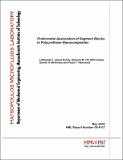Preferential Association of Segment Blocks in Polyurethane Nanocomposites
Author(s)
James-Korley, LaShanda T.; Liff, Shawna M.; Kumar, Nitin; McKinley, Gareth H.; Hammond, Paula T.
Download06-P-07.pdf (2.257Mb)
Metadata
Show full item recordAbstract
Controlling the level of dispersion of silicate layers in polymer matrices through intermolecular interactions and exploiting these interactions to enhance thermomechanical behavior are key challenges in the field of polymer nanocomposites. In this investigation, unmodified Laponite platelets are dispersed in a segmented polyurethane containing polar, hydrophilic soft segments and a hydrophobic hard segment using a novel solvent exchange method and compared to polyurethane nanocomposites containing more hydrophobic hard and soft domains. It was determined that the silicate
layers were preferentially, but not exclusively, attracted to the hydrophilic, polar soft domains. An apparent micro-phase segregated morphology was observed in transmission electron microscopy for this
system, revealing regions of exfoliation and intercalation. According to polarizing optical microscopy, strain-induced alignment is inhibited for this polyurethane nanocomposite, which is reflected in dramatic reductions in tensile strength and ultimate extensibility. In comparison, the Laponite discs appear to be preferentially, but not exclusively, embedded to the hard domains in the segmented polyurethanes containing more hydrophobic hard and soft domains. Exfoliation of the clay platelets leads to enhanced modulus and toughness without a reduction in extensibility. This study provides clues for exploiting silicate-polymer interactions to tune material properties without chemical modification.
Description
Submitted to Macromolecules
Date issued
2007-01-23Series/Report no.
06-P-07
Keywords
Polyurethane nanocomposite, block copolymer polarity, Preferential segregation
Collections
The following license files are associated with this item: